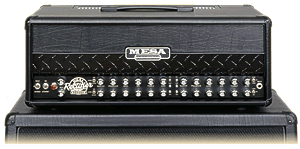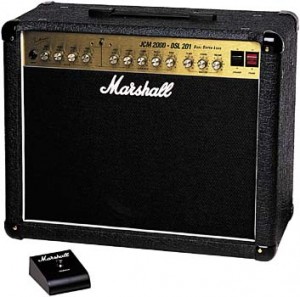Mojave Ampworks impressed us last year with its Peacemaker, a powerhouse of an amp head running EL34s in its power section and providing tones that aim to please a range of rock guitarists. With its 100 watts of output, the Peacemaker was designed for, and best used in, a full-band environment, and preferably those with loud drummers – otherwise consider an attenuator a "must have" device when wanting to get the most out of the Peacemaker.
Continue reading
Category Archives: Amplifier Reviews
Metropoulos Amplification ’68 12000-Series Plexi 100 Watt head
Introduction
"I want an amp that can nail the early Van Halen tone 100% but I don’t have $5,000+ (at the time of this writing – 11/05) for an original Marshall ’67-’68 era plexi." This is what many of you have written to us and asked for in the past. "What should I use?"
Some of you have even had more demanding requirements for your amplifier citing that in addition to the Van Halen tone, you ALSO wanted the ability for the amp to respond and produce tones as diverse as Cream, Jimi Hendrix, Led Zeppelin, and AC/DC, among others.
Continue reading
Celestion Heritage Series G12M and G12H “Greenbacks”
Chances are if you ask a player who uses vintage Marshall amplifiers to name their favorite speaker, they’ll either call out the G12M or G12H “Pre-Rola Greenback” speaker. These two speakers literally defined the sound of rock since the 1960’s and have continued to do so ever since.
Continue reading
Mercury Magnetics Epiphone Valve Junior Mod
The Epiphone Valve Junior is a small 5W amp head that is first most noteworthy because it is, well, cheap. Especially considering it is a tube amplifier, selling for $129 is frankly a bargain. Because of its simplicity and price, it has had a bit of an underground following being a pure-tube circuit with a single 12AX7 in the preamp stage and an EL84 as its output tube running Class A. The amp has 4,8, and 16 ohm output jacks to enable a wide use of cabinets.
Continue reading
My Love/Hate Mesa/Boogie Story, Part II: The Roadster in Review
 Although Mesa first released its Roadster series of amp heads and combos in 2006, it wasn’t until 2008 that I finally tried one. Playing it in the store, I was impressed enough to make the purchase. Based on my playing time since then in various environments, volumes, etc., and coupled with the many experiences of other Boogies I’ve played and owned through the years, to me the Mesa Roadster is THE best amp Mesa has ever produced. No contemporary multi-channel amp I’ve ever played previously had delivered such a consistently great range of tones across each of its channels – suitable for any style of music and user-friendly with any guitar.
Although Mesa first released its Roadster series of amp heads and combos in 2006, it wasn’t until 2008 that I finally tried one. Playing it in the store, I was impressed enough to make the purchase. Based on my playing time since then in various environments, volumes, etc., and coupled with the many experiences of other Boogies I’ve played and owned through the years, to me the Mesa Roadster is THE best amp Mesa has ever produced. No contemporary multi-channel amp I’ve ever played previously had delivered such a consistently great range of tones across each of its channels – suitable for any style of music and user-friendly with any guitar.
Continue reading
THD Electronics Hot Plate Attenuator
It’s not a secret that nothing beats the sound of a great guitar tube amp cranked up. When a tube amp is driven to overdrive, rich and musical even-ordered harmonics flow in abundance and the amplifier seems to take on a new sense of dynamic character that responds better to a player’s touch. It is this feel that gives a tube amp an organic and natural sense, while solid-state amplifiers are considered more sterile in sound because of the lack of this response or harmonics.
The age-old problem has been getting the great tube amp sound at lower and more realistic levels. As the majority of musicians play relatively small clubs and in even smaller practice rooms, only the minority (i.e. those famous guitarists!) get the real opportunity to play these tube amps at the volumes that they sound best. As a result, many of our classic and much beloved Marshall, Fender, and Vox amplifiers are often seen used with distortion and fuzz boxes to compensate. While my personal belief is that these distortion and fuzz boxes are useful in some applications, they are certainly not the best way to achieve great tone when used strictly as the sole source of distortion.
Continue reading
Groove Tubes 6L6GE “Made in U.S.A” Tube
“Made in U.S.A….” For much of what was produced in this country in the past, that term really indicated more than just a manufacturing location. It also indicated pride and true quality of products that were head and shoulders above the rest. In the world of musical instruments, “Made in U.S.A.” today still means the mark of the best quality, but still most expensive instruments made. This wasn’t always the case for many products from the mid-to-late ’70s as quality took a real slide while foreign-run companies made our products look like jokes. But, that said, it is nice to see that today, the quality of products that are made in the U.S. has again dramatically improved. In many aspects of production – for example, the boutique amplifier, guitar, and effects builders based in the U.S., it seems that the sense of pride and workmanship has returned in full form. I can’t think of a better time to have such a great selection of new gear from so many great companies. Yes, there will still be some who say older is “always” better, but I don’t buy that. There are some fantastic guitars, amps, and effects being produced, with strict attention to the details and you’ve got a heck of a lot more choice these days then you did back in the ’50s and ’60s.
Continue reading
Vox Valvetronix AD120VTX Amplifier & Vox Tonelab
The Vox name should be familiar to virtually any guitarist that’s taken that quest for tone or is a regular visitor to this site. That name is of course associated with some of the most famous amplifiers of all time, including the AC15 and AC30. The AC15 had its beginnings in the late 1950’s with the AC30 following soon afterward – and now, even after more than 50 years with the same circuit design at their heart, these are still two amps that continue to be revered for their tone and are as musically useful today as they’ve ever been.
So when Vox announced two years ago that it was moving toward the production of modeling amplifiers, no doubt there was skepticism about what the final product would be like. I’m sure mutterings of “Why mess with a good thing?” were heard and told as well as how a company rooted in “older technology” would do with the creation of amplifiers based on new technology and engineering requirements.
Continue reading
Mojave AmpWorks PeaceMaker and Plexi 45 amp heads
Most readers at this site understand I’m a big time “amp nut” – with a special love for old Marshalls in particular. Some readers have even complained, “Too much Marshall!” in terms of content and asked me to pay attention to some other amps out there.
Well, o.k., I’m going to move away from the Marshalls, but not too far for the moment as the Mojave AmpWorks Peacemaker and Plexi 45 certainly share the Marshall heritage – in the case of the Plexi 45, its circuit is as dead-on of a true JTM 45 clone as you’ll find in any new amp built today. The Peacemaker however, adds some twists to the legendary Marshall tone, which we’ll dig into shortly.
Continue reading
Marshall’s All-Tube 20 Watt Combo – JCM 2000 DSL-201
Throughout its history spanning nearly 40 years, Marshall has continued to produce amplifiers that have been successfully adopted and used by musicians worldwide. As the years progressed, Marshall amplifiers came offered with a variety of additional features to suit the needs and requests of musicians through changing times. Nowadays, a fully equipped Marshall incorporates two or three channels, reverb, an effects loop, speaker-emulated direct outs, additional preamp stage gain, as well as a wide array of independent tones and volume controls for each available channel.
 Power requirements have changed as well. With today’s modern p.a. systems being more than suitable to run the entire band, it is no longer required to run a Marshall stack at full volume and save the p.a. system “just for the vocals”. Today’s guitarists playing club gigs will often mike up through house sound, hence the increased popularity of guitar amplifiers that incorporate their gain within the preamp stage instead of getting distortion by overloading the power tubes. There are benefits and drawbacks to this distortion approach and it is one that truly goes beyond the scope of this article so it will not be discussed here. However, when all is said and done, musicians in general seem to appreciate the added flexibility that additional preamp gain stages provide.
Power requirements have changed as well. With today’s modern p.a. systems being more than suitable to run the entire band, it is no longer required to run a Marshall stack at full volume and save the p.a. system “just for the vocals”. Today’s guitarists playing club gigs will often mike up through house sound, hence the increased popularity of guitar amplifiers that incorporate their gain within the preamp stage instead of getting distortion by overloading the power tubes. There are benefits and drawbacks to this distortion approach and it is one that truly goes beyond the scope of this article so it will not be discussed here. However, when all is said and done, musicians in general seem to appreciate the added flexibility that additional preamp gain stages provide.
Marshall’s JCM 2000 Dual Super Lead series of amps are designed for musicians that require two independent channels of pure tube Marshall tone at a reasonable price. Models are available in a variety of wattages, from the 100 watt DSL 100 head, down to the baby of the line, the 20 watt DSL 201 combo. For those in need of three channels and wish to pay an added premium, Marshall also offers its JCM 2000 Triple Super Lead Series. For this review however, we’ve opted to take a look at Marshall’s 20 watt DSL 201 combo. As a practice amp, or as a club or gigging amp, the DSL 201 offers a wide range of tonal options.
Continue reading